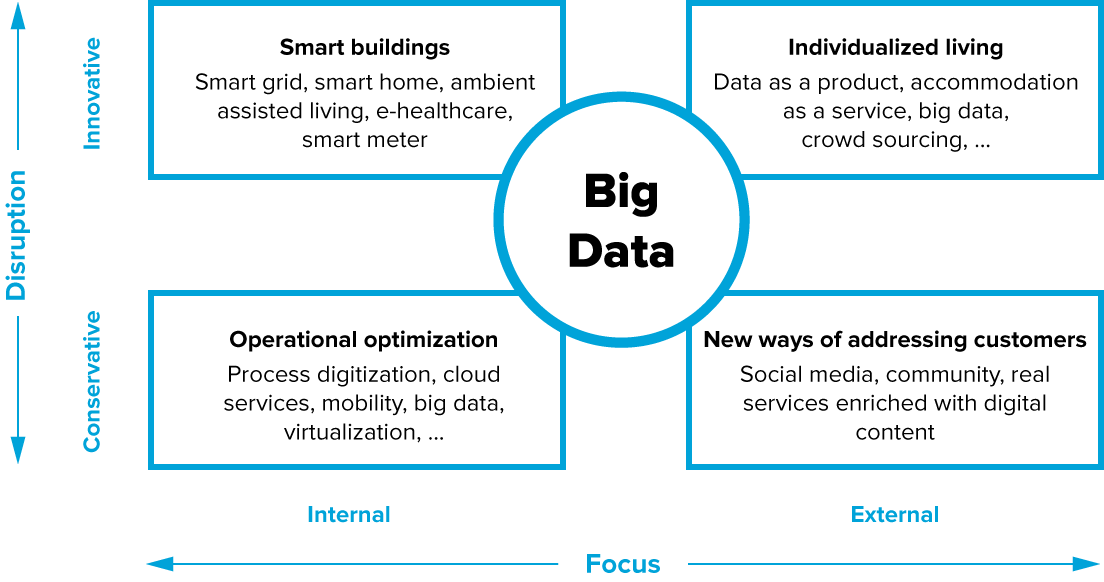Digitization in the Real Estate Sector – How Residential Real Estate Companies Can Identify New Potential
Have you ever heard of Leverton or nuki? Do you know what HUME VALUATE is? If you do, then you must be among the real estate pioneers. Digitization – having already blazed its trail through fintech and insurtech – recently set its sights on the real estate sector, heralding the arrival of proptech.
Digitization – from a buzzword to a cultural shift
Digitization is on everybody’s lips at the moment and it feels like we are hearing daily news of some corporate giant like Siemens or Volkswagen coming out with a new digitization initiative. But what does digitization actually mean? To get one thing out of the way, digitization means more than just using digital media. Digitization has an impact on many different levels (see Figure 1) and therefore deserves comprehensive analysis. 92% of residential real estate companies in Germany firmly believe in the need for digitization in the real estate sector. Against this backdrop, 72% of residential real estate firms have already begun thinking about a digital business model that goes above and beyond their core business.

Figure 1: Areas to be incorporated in a digitization strategy – the innovation matrix2
Only 31% of all residential real estate companies have a fundamental digital strategy for all segments of their business.3 The remaining companies therefore run the risk of falling behind on sociocultural and technical developments in many areas. If they want to avoid this, they will need to ramp up their digitization efforts in various areas of their business. Real estate incumbents are investing a mere 5.5% of annual revenues in digitization at the moment on average. As revenues rise, digitization investments tend to fall as a proportion of sales.4 That said, there is considerable potential to be reaped for residential real estate companies, both on the cost and the income side, owing to the low level of digitization prevalent today.
Operational optimization
From a business perspective, what digitization involves in the first instance is changing and optimizing existing company process through the application of innovative systems (software, hardware). Keeping physical document files, sending faxes and posting letters through the mail are already obsolete activities, at least from a technological point of view. There are, of course, situations where these non-digital methods are unavoidable. What you need to do is identify these and minimize them. In all other situations, consistently digitizing your business processes not only makes life easier for your employees, it also makes everything more transparent. You can offer so many advantages to anyone who needs access to your files by having a digital tenant file which is searchable at a click, easily readable with no messy handwriting, and not physically stored in the archives where they need to go and search for it. And you can rethink many of your internal processes along similar lines, thereby making the working day palpably easier for those involved and creating an organization that is more transparent and more easily manageable all round. Even your commercial and technical support services offer considerable potential for digitization. Tenant inquiries (e.g. damage reports) can be recorded and processed digitally. What this ultimately allows you to do is have your tenants’ entire rental history, from first property viewing to utility cost billing, handled digitally from end to end. Because of course, all of your internal business processes can also be digitized as well – from accounting to purchasing to human resources management.
As you can see, digitization demands some serious thinking about your corporate processes and corporate culture. The majority of residential real estate companies are still in the early stages of digitization. The first step is to bring all currently paper-based business processes into the digital world, making them faster, more efficient and more convenient in the process. This applies to all aspects of rental property management.
Smart buildings
The use of innovative technology enables us to create smart systems which can be used to optimize building construction and building automation. The range of topics affected here spans everything from increasing energy efficiency with the use of a smart grid to the available smart home/ambient assisted living (AAL) systems that make residents’ everyday lives easier and also offers added convenience in the home. What AAL systems can do, for example, is enable elderly or disabled people to live independently in their familiar surroundings. According to a study by the Berlin Institute for Social Research, 58% of female senior citizens and 37% of male senior citizens would use AAL systems if it meant they could continue to live independently.5 The various system components support the residents with everyday activities (e.g. cooking, going to the bathroom at night) and also offer round-the-clock security for users and their family members. Any deviations from the regular day-to-day activities are recognized as potentially dangerous situations (without a panic button and without cameras) and the appropriate parties (e.g. nurses) are automatically informed.
Individualized living
Digitization is fundamentally changing the habits and needs of tenants, a fact which is causing them to question their existing living and working arrangements. Innovative tenancy models which see accommodation as a service will serve to modify the traditional landlord-tenant relationship. In the future, for example, it will be possible to sign a rental contract with a service provider who then takes on additional services for the tenant (e.g. looking for a property, planning the move, letting the property). 56% of real estate incumbents view the Internet of Things as a future trend in the digital technology sphere.6 In particular it will be instrumental in individualized living with its capacity to use microelectronics to embed everyday objects even more strongly into the living environment for residents. Not only that, significant data about the users of various objects can be gleaned through the connectivity of those different objects. The Internet of Things requires a highly developed network infrastructure, which will need to be implemented within the buildings at the appropriate level of quality.
New ways of addressing customers
Currently, 98% of residential real estate companies operate their own website, 22% use an e-mail newsletter to communicate, and only 5% have their own app. None of the real estate companies keep their own blog.7 Digitization offers faster and more efficient ways of keeping in touch with tenants and, from the perspective of the real estate sector, developing additional revenue potential. Tenants can be offered a wide range of additional services primarily aimed at making tenants’ lives easier, but which also enable the real estate sector to participate in the profits under an affiliate model.
One of the options is to offer community services. The good old notice board can be digitized in order to offer a range of additional, up-to-the-minute information: from the garage sale down the street to special events at the local preschool.
And real estate companies will also have the opportunity to publicize specific offers for their tenants from companies in the local neighborhood. Say, a new restaurant that has just opened and is keen to get its name out there. Or a local care service that wants to make life easier for senior citizens. Services like these can be promoted to tenants through smartphone apps and the like. Vandal-proof computer terminals can be made available for older tenants to use. Even the real estate companies themselves could introduce an affiliate model to realize additional revenue potential here.
In a nutshell: Real estate companies should exploit their digital potential
This short overview shows two things quite clearly: real estate companies still find themselves ill prepared for the digital future despite the fact that the home (along with the workplace) is at the heart of our digital society. But the challenges can be overcome. All that is needed is an acknowledgement of the scale of the task and the will to realize sustainable digitization strategies. And then real estate companies may well find themselves setting trends.
Please feel free to contact us if you have any questions or comments on this article or are interested in the digitization of the real estate sector more generally.
Contact
Do you have questions regarding this topic? Please contact:
-
 Dr. Mathias Hain
Dr. Mathias Hain-
email hidden; JavaScript is required
-
email hidden; JavaScript is required
1 Cf. DMK (2015), p. 14.
2 Cf. Bölting et al. (2016), p. 8.
3 Cf. ibid., p. 14.
4 Cf. Scheidecker et al. (2016), p. 11.
5 Cf. Krüger-Brand (2009), n. pag.
6 Cf. Scheidecker et al. (2016), p. 14.
7 Cf. DMK (2015), p. 13